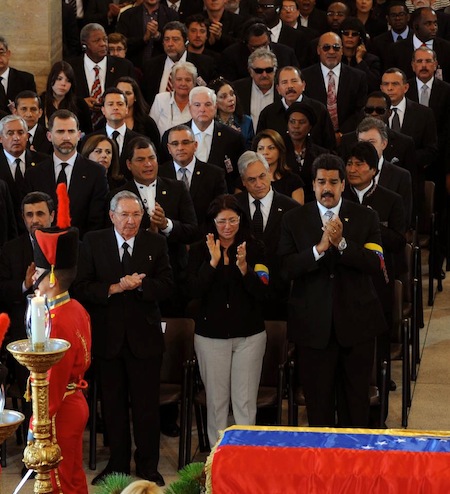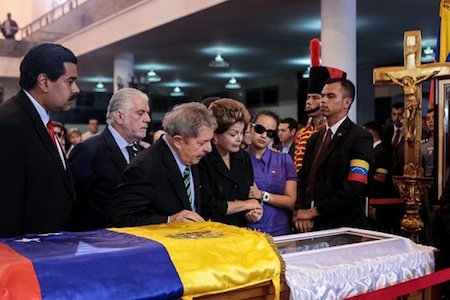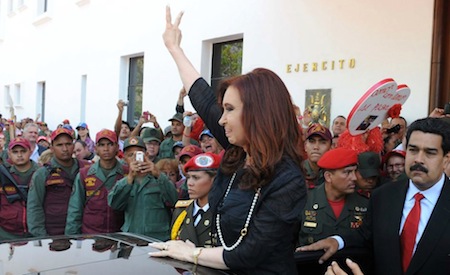What’s always been so interesting about chavismo is the way that the late Venezuelan president Hugo Chávez managed to build alliances both with just about every leader in Latin America, no matter how radical or moderate, while also building close alliances with a ‘who’s who’ of world rogue leaders on poor terms with the United States of America.![]()
It makes for an interesting set of photos from Chávez’s funeral — the photo above comes from the Facebook feed of Enrique Peña Nieto, the president of México, a country that’s had relatively little use for Venezuela over the past 14 years — former president Felipe Calderón used Chávez as a boogeyman in the 2006 Mexican presidential election to warn voters against the one-time leftist frontrunner, former Mexican City mayor Andrés Manuel López Obrador, and that may have made the difference in that election.
Chávez died Tuesday in Caracas after a long fight with cancer, suddenly bringing to life Venezuelan politics that had largely been frozen in waiting on Chávez’s health since his 11-point reelection in October 2012.
Peña Nieto was expected to move Mexican relations closer to Venezuela than under the more right-wing Calderón, but Peña Nieto and Chávez were hardly best friends. That relationship was part and parcel of the diverse set of relationships that Chávez had with the rest of Latin America — sometimes ally, sometimes foil, sometimes donor and often, all three simultaneously. Those relationships, all of which are on display this week in Caracas, give us a rough sense of whether chavismo — and the broader form of the populist, socialist left that has been on the rise in Latin America (though not necessarily in its largest, most economically successful, countries like México and Brazil) — will live beyond Chávez.
Peña Nieto is in the fourth row, standing between businessman Ricardo Martinelli, Panama’s conservative president to his left and Peruvian president Ollanta Humala to his right. Humala, who won a very close election in 2011 in Perú, was feared as a potential chavista radical leftist, anathema to Peru’s business elite, despite renouncing a chavista-style government in Perú. In fact, Humala has turned out to govern as a business-friendly moderate, garnering relatively more criticism from environmentalists and social activists on the left since his election.
There in the front row, you can see Iran’s president Mahmoud Ahmadinejad, Cuba’s president Raúl Castro (who has the distinction of belonging to both the ‘rogue state’ and ‘Latin American’ groups), the new ‘acting’ first lady of Venezuela Cilia Flores, and her husband, acting president Nicolás Maduro.
In the second row, there’s newly reelected Ecuadorian president Rafael Correa; the first right-wing president of Chile in over two decades, Sebastián Piñera; and Bolivia’s left-wing president Evo Morales. Correa and Morales are seen as keen pupils of Chávez’s populist socialist tradition — they are both anti-American (Correa’s embassy in London is harboring Wikileaks founder Julian Assange and Morales has repudiated U.S. anti-coca efforts in Bolivia) and very much interested in using their state resources for the purpose of reducing poverty. Piñera couldn’t be more different in substance and style as a standard business-friendly center-right leader of the first South American member of the Organisation for Economic Co-operation and Development (México is the only other OECD member from Latin America).
Further behind Morales is the relatively conservative president of Colombia, Juan Manuel Santos. Santos and, especially, his predecessor Álvaro Uribe have had very poor relations with Chávez, in part because of ideological differences, in part due to the Colombian government’s narcoterrorism and military collaboration with the United States, and in part because of Venezuela’s suspected role as a haven for anti-government guerrilla rebels, such as the Fuerzas Armadas Revolucionarias de Colombia (FARC, the Armed Revolutionary Forces of Colombia).
Santos is seated next to Laura Chinchilla, Costa Rica’s president, and immediate behind Santos is Teodoro Obiang, the president of Equatorial Guinea, a tiny, autocratic, Spanish-speaking petrostate in the center of Africa’s western coast.
Even further back is Nicaragua’s president, Sandinista-rebel-turned-corrupt-autocrat Daniel Ortega, a familiar face in Latin American politics over the past three decades — Chávez provided a great deal of finance to Ortega, though Ortega’s need for Venezuelan cash is said to have strained that relationship. Seated immediately to Ortega’s left is Honduran president Porfirio Lobo and slightly behind him and to his right is Uruguayan president José Mujica.
Not seen in the photograph above is Belarus’s longtime autocratic president Aleksandr Lukashenko, who also attended the funeral.
Dilma Rousseff and Luiz Inácio Lula da Silva, the president and former president of Brazil, respectively, did not attend the funeral, but paid their respects earlier this week (pictured below):
Lula da Silva and Chávez had a complex, if symbiotic, relationship — Lula da Silva, a former labour leader, came to power as Brazil’s president in 2002. While he governed Brazil in a much more moderate, business-friendly direction than Chávez governed Venezuela, Lula da Silva’s Bolsa Família program was an incredibly activist — and now seen as incredibly successful — program to provide cash grants to Brazil’s poorest citizens. Despite their differences, Lula da Silva publicly supported not only Chávez, but Castro as well, despite U.S. pressure to break ways with Venezuela and Cuba.
As Greg Grandin wrote in The Nation earlier this week, Chávez’s radical antics made Lula da Silva’s own ambitious progressive agenda seem much more moderate in comparison:
Where Chávez was reckless, Lula was moderate. Where Chávez was confrontational, Lula was pragmatic. Lula himself never bought this nonsense, consistently rising to Chávez’s defense and endorsing his election.
For a good eight years they worked something like a Laurel and Hardy routine, with Chávez acting the buffoon and Lula the straight man. But each was dependent on the other and each was aware of this dependency.
Even more complex was the relationship of Castro and his brother Fidel Castro to Chávez, as Francisco Toro wrote earlier this week for The New Republic:
Much has been written about the way Venezuela stepped in to fill the fiscal and strategic void the collapse of the Soviet Union left in Cuba, but the reality is much stranger than that. As the unquestionably senior member of their Cold War alliance, the Soviets treated Cuba as just another satellite state; Fidel’s subjugation to a cold war superpower was always something of an embarrassment to him.
In the Caracas-Havana axis, by contrast, the paymaster doubled up as the vassal. Venezuela effectively wrote a fat petrocheck month after month for the privilege of being tutelaged by a poorer, weaker foreign power.
The extent of this reverse colonization was startling. Cuban flags eventually came to flutter above Venezuelan military bases and Venezuelans witnessed the surreal spectacle of a democratically elected president telling them that Venezuela and Cuba share “a single government” and that Venezuela “has two presidents.” Cuban military advisors kept watch over Venezuela’s entire security apparatus, and had exclusive control over Chávez’s personal security detail. Through most of his 20-month battle with cancer, the Castros had better information about the president’s condition than even his inner circle back home, and they maneuvered successfully to ensure a pro-Havana diehard, Nicolás Maduro, won the tough battle for succession.
Fidel Castro — an old-school anti-American communist revolutionary — took power in Cuba in 1959, and he and his brother Raúl, who took power following Fidel’s health problems in 2006, have ruled the island nation ever since. Chávez was seen as the unofficial leader of the new generation of socialist leaders, though both Castros — Fidel, age 86 and Raúl, age 81 — have now outlived him. Castro took power just seven years after Juan Perón took power for the first time in Argentina, to give you a sense of how long the Castros have ruled Cuba.
To some degree, chavismo is the Latin American sequel to peronismo, which was also a very populist movement, and following the collapse of a decade of neoliberal leadership in the 1990s with the 2001-02 peso crisis, Argentina’s leadership under the late Néstor Kirchner and now, under his widow, Cristina Fernández de Kirchner, is in many ways a revival of peronismo in Argentina, and Fernández de Kirchner has taken an increasingly nationalist and populist tone as president with high inflation plaguing the Argentine economy and world credit markets unwilling to finance a country that unilaterally cancelled its debt to the International Monetary Fund in 2005.
Fernández de Kirchner (pictured below), was also unable to attend the funeral, despite a trip earlier in the week to pay respects to Chávez. Argentina faces another potential default in 2013, and Chávez has provided Kirchner not only political support, but also subsidized oil, a credit lifeline and other tangible benefits (including, perhaps, campaign funds for the Kirchners).
Chávez’s rank-and-file Venezuelan supporters have been snaking their way to view his remains all week long, standing hours in a mile-long queue for the privilege — Maduro announced earlier this week that the Venezuelan government will embalm Chávez in perpetuity, like Lenin and Mao, in a mausoleum in Caracas.
They will likely support Maduro, Chávez’s former foreign minister and only recently his newly appointed vice president, and now acting president, in the snap presidential election expected to be called in the next 30 days, and it seems more likely than not that the sympathy for Chávez will overpower Venezuelan frustrations over its economic woes, widespread outages and shortages, and ever-increasing violent crime to power him to a full term over Chávez’s former rival in the October 2012 presidential election, Henrique Capriles, the young governor of Miranda state.
While Maduro seems unlikely to break with Chávez’s agenda completely, which means that U.S.-Venezuelan relations are unlikely to improve suddenly, Friday’s funeral makes clear that it’s not only Venezuela that has an interest in the country’s future.
Whether U.S. commentators and policymakers like it or not, Chávez occupied a key role on the world stage, and especially on the Latin American stage, and no leader, from México to Chile, from Brazil to Honduras, is unlikely to be immune from the effects of what happens to chavismo.




2 thoughts on “World leaders descend upon Chávez funeral: one photo, but mil palabras”